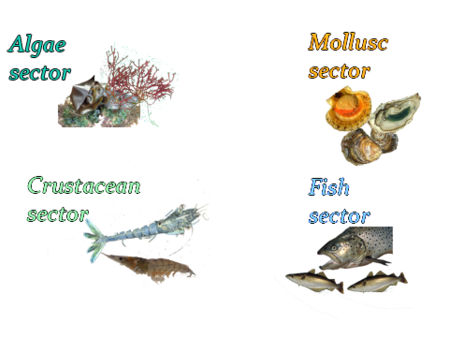Cupped oysters
Name : | Japanese cupped oyster |
|---|---|
Scientific mane : | Crassostrea gigas |
Size : | "Wild" oysters can grow to more than 25 cm and weigh more than a kg, but an inter-professional size grid was adopted and the marketable size was set at 30 g. The grid specifies the number of oysters per package according to a 1-5 grade range. Oysters of up to 150 g are commonly consumed. |
History: from the pioneers to present…
These oysters are naturally found in the Pacific Ocean and were imported into France between 1966 and 1974 from British Columbia (genitors) and Japan (spat) to replace Portuguese oysters whose populations were decimated by two virus diseases. Nowadays, spat supplies for all oyster beds along the French coasts are obtained mainly from Arcachon and Charente Straits.
Culture techniques and production cycle
The spat is mainly collected in the natural environment by spat setting on collectors. However, hatchery spat production is increasing. The period from the beginning of culture until marketing can range from 1 to 4 years, depending on the production site and techniques implemented.
Oyster yields in France in 2001 (tons)
Brittany, Poitou-Charentes and Normandy are the three main countries producing cupped oysters (Agreste 2001). External trade is relatively limited
Product value enhancement
Cupped oysters are generally consumed raw in France. They are more readily consumed by relatively wealthy people over 50 years old (SECODIP study). This confirms that oysters have an exceptional deluxe product image, and are considered to foster the transmission of family traditions (Louis Harris/BG Conseils study). Oyster sales are focused around the months "with R" Christmas and New Year holiday period, and more generally during the from September to April when the oysters are not "milky". A sterile triploid oysters variety was recently bred which could be consumed throughout the year. In some production areas, oysters can be placed in "claires" (salt marsh ponds) to enhance growth. These are called "fine" or "special" claires oysters.
Cupped oyster figures (2001)
In 2001, a first shellfish culture survey highlighted cupped oyster marketing patterns in France. (source Agreste 2002). Import/export data are produced by Ofimer/French customs.
For the most recent statistics, see the valuation on the website of CNC and Government website
107 390 | Cupped oysters reported to have been marketed in France in 2001 |
|---|---|
14 180 | hectares used for oyster culture |
3 750 | shellfish culture companies in France |
2 740 | shellfish culture companies selling oysters for consumption |
2,1 | full-time employees per company on average, mainly year-end seasonal employment |
28 | percent of the production sold directly to consumers |
26 | percent of the production sold to supermarkets |
23 | percent of the production sold to wholesalers |
2,7 | million tons of oysters imported into France in 2003, mainly from Ireland |
5,9 | million tons of oysters exported by France in 2003, generally large-sized oysters to Italy |
Strengths / Weaknesses
Strengths | Weaknesses |
|---|---|
|
|

